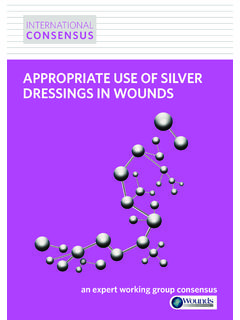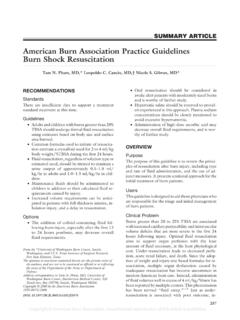Transcription of Exposure to blood or other body fl uids - WHO
1 CHAPTER 8. Exposure to blood or other body fluids blood transfusion blood transfusion is a life-saving intervention. When used correctly, it saves lives and improves health. However, blood transfusion carries a potential risk of acute or delayed reactions and transfusion-transmitted infections and should be pre- scribed only to treat conditions associated with significant morbidity that cannot be prevented or managed effectively by other means. For travellers, the need for a blood transfusion almost always arises as a result of a medical emergency involving sudden massive blood loss, such as: traffic accident gynaecological or obstetric emergency severe gastrointestinal haemorrhage emergency surgery. The safety of blood and blood products depends on two key factors: A supply of safe blood and blood products through the careful selection of voluntary unpaid blood donors from low-risk populations that donate repeat- edly, testing all donated blood for transfusion-transmissible infections and correct storage and transportation at all steps from collection to transfusion with adequate quality system.
2 The appropriate prescription (only when there is no other remedy), proper cross-match between the blood unit and the recipient, and safe administration of the blood or blood product at the bedside, with correct patient identifica- tion. In many developing countries, safe blood and blood products may not be available in all health care facilities. In addition, evidence from every region of the world indicates considerable variations in patterns of clinical blood use between differ- ent hospitals, different clinical specialties and even between different clinicians within the same speciality. This suggests that blood and blood products are often transfused unnecessarily. 171. INTERNATIONAL TRAVEL AND HEALTH 2009. While blood transfusions correctly given save millions of lives every year, unsafe blood transfusions as a result of the incompatibility of the blood , volume trans- fused or the transmission of infections such as hepatitis B, hepatitis C, human immunodeficiency virus (HIV) malaria, syphilis or Chagas disease can lead to serious reactions in the recipient.
3 The initial management of major haemorrhage is the prevention of further blood loss and restoration of the blood volume as rapidly as possible in order to maintain tissue perfusion and oxygenation. This requires infusing the patient with large volumes of replacement fluids until control of haemorrhage can be achieved. Some patients respond quickly and remain stable following the infusion of crystalloids or colloids and may not require blood transfusion. In malaria-endemic areas, there is a high risk of acquiring malaria from transfu- sion. It may be necessary to administrate the routine treatment for malaria to the transfused patient (see Chapter 7). Precautions Travellers should carry a medical card or other document showing their blood group and information about any current medical problems or treatment. Unnecessary travel should be avoided by those with pre-existing conditions that may give rise to a need for blood transfusion.
4 Travellers should take all possible precautions to avoid involvement in traffic accidents (see Chapter 4). Travellers should obtain a contact address at the travel destination, in advance, for advice and assistance in case of medical emergency. Travellers with chronic medical conditions, such as thalassaemia or haemophilia, that necessitate regular transfusion of blood or plasma-derived products should obtain medical advice on the management of their condition before travelling. They should also identify appropriate medical facilities at their travel destination and carry a supply of the relevant safe products with them, if appropriate. Accidental Exposure to blood or other body fluids Exposure to bloodborne pathogens may occur in case of: contact with blood or body fluids with a non-intact skin or with mucous membranes;. percutaneous injury with needles or sharp instruments contaminated with blood or body fluids. 172. CHAPTER 8.
5 Exposure TO blood OR other BODY FLUIDS. These exposures may occur: when using contaminated syringes and needles for injecting drugs;. as a result of accidents or acts of violence, including sexual assaults;. in case of sexual Exposure if there was no condom use, or if the condom was broken;. as occupational Exposure , within and outside health care settings, to health care and other workers (such as rescuers, police officers) in the course of the work or to patients;. during natural or man-made disasters. Accidental Exposure may lead to infection by bloodborne pathogens, particularly hepatitis B, hepatitis C and HIV. The average risk of seroconversion after a single percutaneous Exposure to infected blood for hepatitis C is approximately 2%. and for hepatitis B it is 6 60%. The average risk of seroconversion to HIV after a single percutaneous Exposure to HIV-infected blood is The risk of transmission through Exposure to infected fluids or tissues is believed to be lower than that through Exposure to infected blood .
6 Pre- Exposure vaccination. Hepatitis B vaccination can be given to protect trav- ellers from hepatitis B infection prior to Exposure (see Chapter 6). There are no vaccines for hepatitis C or HIV. Post- Exposure prophylaxis (PEP). PEP is an emergency medical response given as soon as possible to reduce the risk of transmission of bloodborne pathogens after potential Exposure . It is available for HIV and hepatitis B. Accidental Exposure to potentially infected blood or other body fluids is a medical emergency. The following measures should be taken without delay: 1. Refer to a service provider and report the accident. 2. First-aid care. 3. PEP, if applicable. First-aid care management of Exposure to bloodborne pathogens After percutaneous Exposure Allow the wound to bleed freely. Do not squeeze or rub the injury site. Wash site immediately using soap or a mild solution that will not irritate the skin. 173. INTERNATIONAL TRAVEL AND HEALTH 2009.
7 If running water is not available, clean site with a gel or hand-cleaning solu- tion. Do not use any strong solutions, such as bleach, iodine or alcohol-based products, as these may irritate the wound and make the injury worse. After a splash of blood or body fluids onto unbroken skin Wash the area immediately with running water. If running water is not available, clean the area with a gel or hand-cleaning solution. Do not use alcohol-based antiseptics. After Exposure of the eye Irrigate exposed eye immediately with water or normal saline. Sit in a chair, tilt the head back and ask a person to gently pour water or normal saline over the eye, gently pulling the eyelids up and down to make sure the eye is cleaned thoroughly. If wearing contact lenses, leave them in place while irrigating, as they form a barrier over the eye and will help protect it. Once the eye has been cleaned, remove the contact lenses and clean them in the normal manner.
8 This will make them safe to wear again. Do not use soap or disinfectant on the eye. After Exposure of the mouth Spit the fluid out immediately. Rinse the mouth thoroughly, using water or normal saline, and spit out again. Repeat this process several times. Do not use soap or disinfectant in the mouth. In all cases, a health care worker should be contacted immediately. Post- Exposure prophylaxis (PEP). HIV. For HIV, PEP refers to a set of comprehensive services to prevent HIV infection in the exposed individual. These services include risk assessment and counselling, HIV testing based on informed consent and according to the risk assessment 174. CHAPTER 8. Exposure TO blood OR other BODY FLUIDS. the provision of short-term antiretroviral (ARV) drugs, with follow-up and support. PEP should be started as soon as possible after the incident and ideally within less than 2 hours. The decision to provide ARV drugs depends on a number of factors, including the HIV status of the source individual, the nature of the body fluid involved, the severity of Exposure and the period between the Exposure and the beginning of treatment.
9 PEP should not be given to people who test or are known to be HIV-positive. The recommended PEP regimen is, in most cases, a combination of two ARV. drugs that should be taken continuously for 28 days. In some instances, when drug resistance may be suspected in the source person, a third drug may be added. Expert consultation is especially important when Exposure to drug-resistant HIV. may have occurred. More information is obtainable at: prophylaxis/en/. If HIV testing has been done, subsequent tests should be repeated 6 weeks, 3 months and 6 months following Exposure . People who test positive at these stages should be offered psychological support and appropriate treatment when needed. After accidental Exposure , the exposed individual should not have unprotected sexual intercourse, or give blood until the 6-month post- Exposure tests confirm that he or she is not seropositive. Women should avoid becoming pregnant during this period.
10 Hepatitis B. For those who may be exposed to hepatitis B virus, infection can be pre- vented before Exposure through vaccination and after Exposure through PEP. Recommended post- Exposure management algorithms for testing and administration of hepatitis B vaccine and/or hepatitis B immune globulin should be followed. Hepatitis C. There is no vaccine against hepatitis C virus. People exposed to hepatitis C virus may be screened for hepatitis C virus RNA at baseline, 4 6 weeks and 4 6 months after Exposure . Hepatitis E. There is no commercially available vaccine against hepatitis E virus. People ex- posed to hepatitis E virus may be screened for anti-HEV IgM antibodies or for hepatitis E virus RNA. 175. INTERNATIONAL TRAVEL AND HEALTH 2009. Further reading The clinical use of blood in general medicine, obstetrics, paediatrics, surgery and anaesthesia, trauma and burns. Geneva, World Health Organization, 2001. Post- Exposure prophylaxis for HIV: Updated Public Health Service Guidelines for the Management of Occupational Exposures to HBV, HCV, and HIV and Recommendations for Postexposure Prophylaxis.















